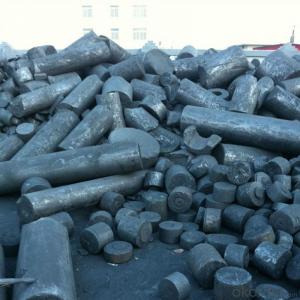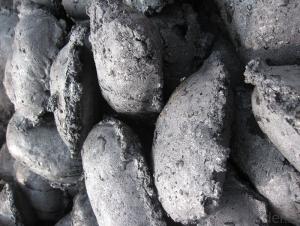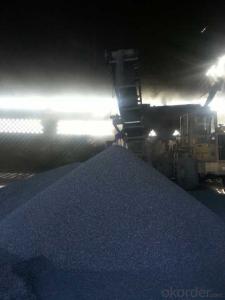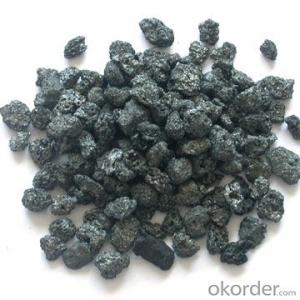Graphite Electrode Scrap high-purity as carbon additive and carburant
- Loading Port:
- Qingdao
- Payment Terms:
- TT OR LC
- Min Order Qty:
- 10 m.t
- Supply Capability:
- 5000000 m.t/month
OKorder Service Pledge
Quality Product, Order Online Tracking, Timely Delivery
OKorder Financial Service
Credit Rating, Credit Services, Credit Purchasing
You Might Also Like
Specifications:
F.C 98%min and 98.5%min, size: 100mm up
- Description & Application
Electrode block processing of carburant in steelmaking and casting, than ordinary recarburizer absorption rate is high, easy to melt, can efficiently improve the quality of products and reduce the cost.
- Technical Specification
F.C (min) |
| 98% |
S (max) |
| 0.05% |
ASH (max) |
| 1.00% |
Vm (max) |
| 1.00% |
H2O (max) |
| 0.50% |
SIZE |
| |
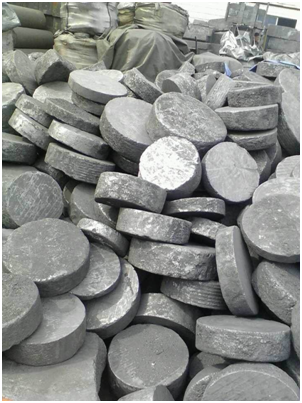
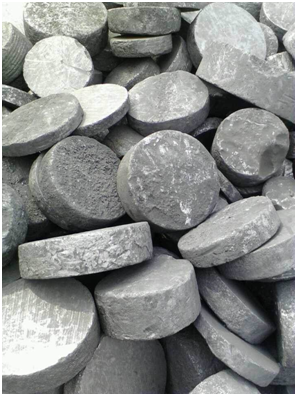
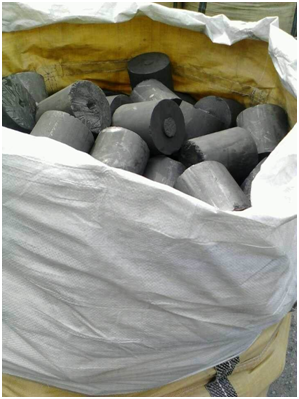
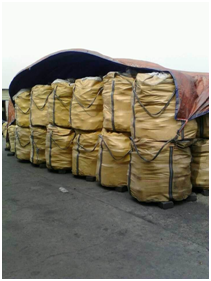
- Q:Consult the carbon content of austenite
- Pure iron carbon alloys, austenitic (A) carbon content in different grades, different temperature and different, in more than 727 degrees (727 degrees when the carbon content is 0.77%), 1148 degrees, 2.11% carbon content with see iron carbon phase diagram
- Q:Will long-term use of carbon alloy chopsticks cause cancer?
- The chopsticks are washed with water for a long time, and the water content is especially high. The chopsticks are placed in the non ventilated place for a long time, and the chances of deterioration of the chopsticks are improved." Huang Yahui said, especially the moldy chopsticks, may be contaminated by aflatoxin. It is understood that aflatoxin is the 1 class of carcinogens, is a highly toxic highly toxic substances, human and animal liver tissue will have a damaging effect, can lead to serious liver cancer or even death. Huang Yahui warned that the public should be weekly chopsticks into boiling water after half an hour, placed in the air to air dry before use, it can achieve the disinfection effect, and can effectively and conveniently remove mildew in chopsticks. In addition, it is best to use half a year to replace the new chopsticks, so you don't have to worry too much. "The selection of chopsticks is also very exquisite."." Huang Yahui said, "the ideal chopsticks are bamboo chopsticks and non staining wooden chopsticks.". After the dyed or painted wood, paint and stain will enter the body with food. When in use, especially the stain in heavy metals, benzene and other harmful substances, can cause gastrointestinal inflammation, ulceration, erosion, serious can cause cancer.
- Q:How does carbon affect the water cycle?
- The water cycle is affected by carbon in various ways. To begin with, carbon plays a vital role in the atmosphere as carbon dioxide (CO2). Human activities such as burning fossil fuels, deforestation, and industrial processes have caused an increase in the concentration of CO2 in the atmosphere. This rise in carbon dioxide levels leads to global warming and climate change, which then impacts the water cycle. One significant consequence of increased carbon dioxide is the alteration of precipitation patterns. Carbon emissions cause warmer temperatures, resulting in more evaporation from bodies of water. This leads to an increase in water vapor in the atmosphere. The additional moisture can lead to intensified rainfall in certain areas, causing floods. On the other hand, some regions may experience droughts as evaporation rates surpass precipitation rates. These changes disrupt the balance of the water cycle and affect the availability of water resources for both humans and natural systems. Moreover, carbon dioxide dissolved in water forms carbonic acid, which lowers the pH level of oceans and bodies of water. This process, known as ocean acidification, has a negative impact on marine life, including shellfish, corals, and other organisms that rely on calcium carbonate to build their shells or skeletons. Consequently, the disruption of these species can have a domino effect through the food chain, ultimately affecting the entire ecosystem. Additionally, carbon influences the melting of polar ice caps and glaciers. Increased carbon emissions have caused a rise in global temperatures, which accelerates the melting process. As the ice melts, it releases freshwater into the oceans, leading to a rise in sea levels. This can have devastating consequences for coastal communities, increasing the risks of flooding and erosion. In conclusion, carbon emissions, mainly in the form of carbon dioxide, have a significant impact on the water cycle. They disrupt precipitation patterns, contribute to ocean acidification, and accelerate ice melting. All of these effects disturb the delicate balance of the water cycle and have far-reaching consequences for ecosystems and communities worldwide.
- Q:What are the industrial uses of diamonds?
- Diamonds have various industrial uses due to their exceptional hardness and thermal conductivity. They are commonly used as abrasives in cutting, grinding, and polishing tools for materials like glass, ceramics, and metals. Additionally, diamonds are utilized in the production of high-quality drill bits for drilling wells and mining operations. Their thermal conductivity makes them valuable in heat sink applications, such as in the manufacturing of computer chips and laser technology. Diamonds are also employed in the production of specialized lenses and windows for high-pressure research and industrial lasers.
- Q:Process for producing carbon fiber board
- What is the production process of carbon fiber?For the production process of carbon fiber, when the PAN based carbon fiber is produced, the polyacrylonitrile fiber, which is called the parent fiber, is firstly prepared by polymerization and spinning process. These are then placed in an oxidizing furnace and oxidized at 200 to 300 degrees celsius. In addition, carbon fibers are also carbonized in the carbonization furnace at temperatures between 1000 and 2000 degrees celsius. In addition to the conventional type of fine carbon fiber, the PAN based carbon fiber also includes coarse fiber, known as the "tow man type carbon fiber", which costs less to produce the crude fiber.If you can not understand that there are other carbon fiber net professional look, introduce a carbon fiber network via Wuxi to see you, the above information and pictures very much, I often go to their website to learn.
- Q:How does carbon affect the migration patterns of birds?
- Carbon emissions and the resultant climate change have a significant impact on the migration patterns of birds. The increase in carbon dioxide levels in the atmosphere leads to global warming, which affects various environmental factors such as temperature, precipitation, and vegetation growth. These changes directly influence the availability of food, water, and suitable habitats for birds during their migratory journeys. One of the key ways carbon affects bird migration is by altering the timing and duration of seasonal events. For instance, warmer temperatures can cause plants to bloom earlier or delay their growth, disrupting the synchronized timing of flowering and the arrival of insects. This can have serious consequences for birds that rely on these resources for food during their migration. If birds arrive at their breeding grounds or stopover sites and find a lack of food, it can lead to decreased survival rates, reduced reproductive success, and overall population decline. Additionally, changes in precipitation patterns due to carbon emissions can affect the availability of water sources along migration routes. Birds rely on these water bodies for drinking and bathing, especially during long flights. If these water sources dry up or become scarce, it can force birds to alter their flight paths, search for alternative water sources, or even risk dehydration. Furthermore, carbon-induced changes in vegetation cover can impact the availability of suitable habitats for birds. As temperatures rise, some bird species may face challenges in finding suitable breeding or nesting sites. Forest-dwelling birds, for example, may experience habitat loss as forests are degraded or replaced by drier ecosystems. This can disrupt their migratory patterns and potentially lead to population declines or range shifts. Overall, the impact of carbon emissions on bird migration patterns is complex and multifaceted. As climate change continues to unfold, it is crucial to mitigate carbon emissions and implement conservation measures to ensure the survival and well-being of migratory bird populations. Protecting crucial stopover sites, promoting habitat restoration, and raising awareness about the consequences of carbon emissions can all contribute to preserving the intricate and vital phenomenon of bird migration.
- Q:Now the furnace rock carbon early deleted, more than +10, he wants advanced I can't do ah
- High-grade furnace rock carbon is in the previous time, Tencent limited, only the mall can buy! Now, the mall is off the shelf! It's already gone! Thank you!
- Q:What are the properties of carbon-based textiles?
- Carbon-based textiles have a number of unique properties that make them advantageous in various applications. Firstly, carbon-based textiles exhibit exceptional strength and durability. They are known for their high tensile strength, making them resistant to stretching and tearing. This property allows carbon textiles to withstand harsh conditions and maintain their integrity over time. Secondly, carbon-based textiles possess excellent thermal conductivity. They can efficiently conduct heat, making them suitable for applications that require effective heat management. This property is particularly useful in industries such as aerospace, automotive, and electronics, where heat dissipation is essential to prevent system failures. Furthermore, carbon textiles are highly resistant to chemical corrosion. They can withstand exposure to various chemicals, acids, and solvents without losing their structural integrity. This property makes carbon-based textiles ideal for applications in the chemical industry, where exposure to corrosive substances is common. Another notable property of carbon textiles is their inherent flame resistance. They have a high resistance to ignition and do not propagate flames easily. This characteristic makes them suitable for use in environments where fire safety is crucial, such as in protective clothing for firefighters and military personnel. Carbon-based textiles also exhibit good electrical conductivity, making them suitable for applications in electronics and electrical engineering. They can effectively conduct electricity and dissipate static charges, reducing the risk of electrical malfunctions or damage. Lastly, carbon textiles have a low coefficient of thermal expansion, meaning they do not expand or contract significantly with changes in temperature. This property makes them dimensionally stable, ensuring that they maintain their shape and size under varying thermal conditions. In summary, carbon-based textiles possess a combination of strength, durability, thermal conductivity, chemical resistance, flame resistance, electrical conductivity, and dimensional stability. These properties make them highly versatile and suitable for a wide range of applications in various industries.
- Q:How are carbon markets regulated?
- Carbon markets are regulated through a combination of international, national, and regional frameworks that aim to ensure the integrity and transparency of emissions trading. One of the main international bodies overseeing carbon markets is the United Nations Framework Convention on Climate Change (UNFCCC), which established the Kyoto Protocol and the Paris Agreement. Under the Kyoto Protocol, an international emissions trading system was created, allowing countries to trade emission allowances through the Clean Development Mechanism (CDM) and Joint Implementation (JI) projects. The CDM and JI projects are approved and monitored by the UNFCCC, which ensures that emission reductions are real, measurable, and additional to what would have occurred without the project. The Paris Agreement, which succeeded the Kyoto Protocol, introduced a new market mechanism called the Sustainable Development Mechanism (SDM). The SDM aims to promote sustainable development and help countries achieve their climate goals by enabling emission reductions and removals through projects in developing countries. At the national and regional level, governments and regulatory bodies play a crucial role in the regulation of carbon markets. They establish legal frameworks, set emission reduction targets, and develop domestic emissions trading systems. These systems typically involve the allocation of emission allowances to companies or sectors, monitoring and reporting of emissions, and the trading of allowances on regulated platforms. To ensure the integrity of carbon markets, strict regulations are put in place to prevent fraud, double-counting, and other forms of market manipulation. Independent verification and accreditation bodies are responsible for auditing emissions data and project methodologies to ensure compliance with the established rules and standards. Furthermore, market oversight and enforcement bodies are established to monitor and enforce compliance with the regulations. These bodies have the authority to investigate and penalize any non-compliance, including imposing fines or revoking emission allowances. Overall, the regulation of carbon markets involves a complex network of international agreements, national legislation, and regulatory bodies. The aim is to create a robust and transparent market that incentivizes emission reductions and supports the transition to a low-carbon economy.
- Q:What are the impacts of carbon emissions on the stability of coral reefs?
- Carbon emissions have significant impacts on the stability of coral reefs. Increased carbon dioxide levels in the atmosphere lead to ocean acidification, which hinders coral reef growth and weakens their structural integrity. Additionally, rising sea temperatures due to carbon emissions result in coral bleaching, where corals expel the symbiotic algae they depend on for survival. These combined effects make coral reefs more susceptible to disease outbreaks, slow recovery from disturbances, and ultimately increases the risk of their collapse, posing a significant threat to marine biodiversity and coastal communities that rely on them.
1. Manufacturer Overview |
|
|---|---|
| Location | |
| Year Established | |
| Annual Output Value | |
| Main Markets | |
| Company Certifications | |
2. Manufacturer Certificates |
|
|---|---|
| a) Certification Name | |
| Range | |
| Reference | |
| Validity Period | |
3. Manufacturer Capability |
|
|---|---|
| a)Trade Capacity | |
| Nearest Port | |
| Export Percentage | |
| No.of Employees in Trade Department | |
| Language Spoken: | |
| b)Factory Information | |
| Factory Size: | |
| No. of Production Lines | |
| Contract Manufacturing | |
| Product Price Range | |
Send your message to us
Graphite Electrode Scrap high-purity as carbon additive and carburant
- Loading Port:
- Qingdao
- Payment Terms:
- TT OR LC
- Min Order Qty:
- 10 m.t
- Supply Capability:
- 5000000 m.t/month
OKorder Service Pledge
Quality Product, Order Online Tracking, Timely Delivery
OKorder Financial Service
Credit Rating, Credit Services, Credit Purchasing
Similar products
New products
Hot products
Hot Searches
Related keywords


